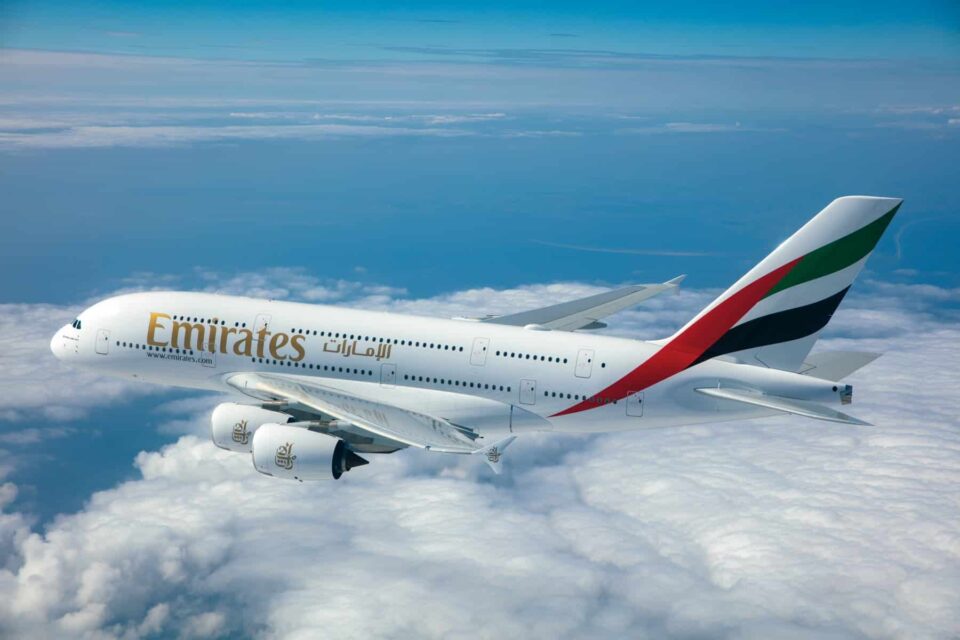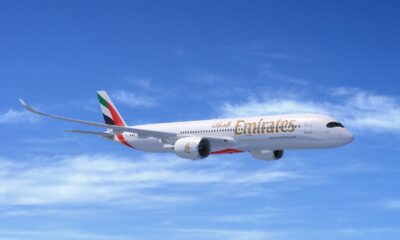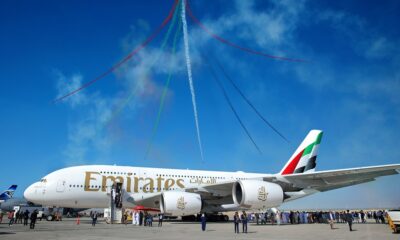Airlines
Emirates recycles more than 500,000 kilograms of plastic and glass in one year

Emirates has recycled more than 500,000 kilograms of plastic and glass over the course of 2022, by collecting discarded bottles onboard for repurposing. 500,000 kilograms is almost the same weight as a fully loaded Emirates flagship A380 aircraft.
Onboard every flight that lands in Dubai, Emirates Cabin Crew work hard to quickly separate glass and plastic bottles, before they are sent to a recycling plant in Dubai. The glass is separated by colour and crushed. This ‘cullet’ or recycled glass that is ready to be re-melted, is then sent to glass manufacturers in the UAE to include in their batch mix for new bottles. The plastic bottles are cleaned, chopped into flakes, melted into pellets, and sent to manufacturers to make other plastic products. As a result, Emirates and Emirates Flight Catering divert thousands of kilograms of glass and plastic away from landfill each year.
Alaska Airlines eliminates inflight plastic cups(Opens in a new browser tab)
The glass and plastic recycling initiative onboard was suggested by environmentally conscious Emirates Cabin Crew in 2019, as part of regular webinars and events where they are given a platform to share feedback and encouraged to share innovative ideas to key departments. The proposal was well-received and implemented within weeks.
Emirates blankets made from recycled plastic
For the last 6 years, Emirates has offered cosy sustainable blankets made from recycled plastic bottles to Economy passengers on long haul flights. The soft and warm blankets are made from 28 recycled plastic bottles. The fine thread is then woven into soft blankets. Over the 6 years since the initiative was introduced, Emirates blankets have prevented more than 95 million plastic bottles from going to landfill. As the largest sustainable blanket programme on board in the airline industry, the manufacturing process of using recycled polyethylene terephthalate (rPET) also reduces energy emissions by around 70%.
Prioritising responsible sourcing
Consuming responsibly is a key environmental focus area for Emirates, who have embedded an environmental requirement in the supplier code of conduct and consider the entire lifecycle of products from the design stage. For example, wooden tea and coffee stirrers, paper straws and inflight retail bags are made using wood and paper from responsibly managed forests.
Emirates children’s toys made from sustainably sourced material
For Emirates’ youngest customers, the airline’s complimentary toy bags, baby amenity kits and plush toys are also made from recycled plastic bottles and other sustainable materials. Belt bags, duffle bags and backpacks are designed with specific age groups in mind and are constructed from a yarn that is made from 100% recycled plastic bottles. Each Emirates kids’ backpack is made from 5.5 recycled plastic bottles and each duffle bag is made from 7. The production of the Emirates children’s bags has saved 8 million plastic bottles from landfill. The swing tags are made from recycled card, and even the outer cases that the products are shipped in are made from recycled card that can be recycled again.
Emirates reusable onboard amenity kits
Emirates’ Premium Economy and Economy Class range of amenity kits are complimentary for customers on long-haul flights, and feature designs that represent the four essential elements of nature – fire, water, earth, and air. The pouches are reusable and made from washable kraft paper with bespoke art printed in non-toxic soy-based ink. The contents include a selection of durable travel essentials made from environmentally friendly materials. The toothbrush is made from a combination of wheat straw and plastic, and the socks and eyeshades are made from recycled plastic, in this case, rPET (recycled polyethylene terephthalate). The packaging used for the dental kit, socks and eyeshades is made from 90 per cent rice paper.

Airlines
A software error caused grounding the entire airline fleet

On Wednesday, the U.S. Federal Aviation Administration (FAA) issued a ground stop advisory for all Alaska Airlines and subcarrier flights due to a software issue, disrupting travel plans for passengers.
The FAA directive, which prohibited the departure of Alaska Airlines mainline and subcarrier flights, was implemented as a precautionary measure following the detection of the software problem. The ground stop was initiated after Alaska Airlines encountered difficulties during a system upgrade related to the calculation of weight and balance for their flights.
As a result, the airline opted for a temporary suspension of all its operations to address the issue and ensure passenger safety. Alaska Airlines promptly issued a statement acknowledging the incident and expressing their commitment to resolving the matter swiftly. “This morning we experienced an issue while performing an upgrade to the system that calculates our weight and balance.
Out of an abundance of caution, we requested a ground stop for all Alaska and Horizon flights, which was instituted at approximately 7:30 a.m. PT,” the statement read. Passengers affected by the disruption voiced their concerns on social media platforms, prompting Alaska Airlines to reassure them of their efforts to minimize the inconvenience and expedite the resumption of flights.
Following approximately an hour-long interruption, the FAA lifted the ground stop order, allowing Alaska Airlines and its subcarriers to resume normal operations. However, it was clarified that SkyWest, which provides regional service for Alaska Airlines and other carriers, was exempt from the ground stop and continued its flights unaffected.
Aerospace
Which is bigger 777x or 787 aircraft ?

The 777X is a new series of the Boeing 777 family and is designed to be larger and more efficient than its predecessor. It features two variants: the 777-8 and the 777-9, being the larger of the two.
The Boeing 777X emerges as the larger sibling within the Boeing family, representing a significant leap forward in both size and efficiency. Comprising two variants, the 777-8 and the 777-9, the latter takes the crown as the larger of the two. With its expansive fuselage and impressive wingspan, the 777X is tailored for long-range journeys and boasts a substantial passenger capacity.
On the other hand, the Boeing 787, affectionately known as the Dreamliner, occupies a niche in the market as a smaller yet formidable aircraft designed for medium to long-range flights. Its distinguishing feature lies in its composite fuselage, a technological marvel that renders it lighter and more fuel-efficient compared to conventional aluminum counterparts. The Boeing 777X is larger than the Boeing 787 aircraft.
When it comes to passenger capacity, the 777-9 reigns supreme, typically accommodating a sizeable contingent of 400-425 passengers in its standard configuration. In contrast, the 787, with its more modest dimensions, typically carries between 240-290 passengers, depending on the variant and layout.
One of the remarkable innovations introduced with the 777X is its folding wingtips, a feature designed to address the logistical challenges of accommodating such a large aircraft in conventional airport gates. These folding wingtips enable the 777X to retract its wings, allowing it to fit into gates designed for smaller aircraft while still reaping the benefits of an extended wingspan during flight, thereby enhancing fuel efficiency and operational flexibility
Airlines
Why Don’t Airplanes Fly Over the Pacific Ocean?

Flights do indeed fly over the Pacific Ocean, but the routes they take are often determined by factors such as airline policies, air traffic control decisions, and weather conditions. The Pacific Ocean is one of the largest bodies of water on Earth, and it’s regularly crossed by numerous flights traveling between North America, Asia, Australia, and other destinations.
However, some specific routes might avoid flying directly over certain parts of the Pacific Ocean for various reasons. For example:
- Safety and emergency considerations: While modern aircraft are equipped with advanced safety features, airlines, and pilots may prefer routes that keep them closer to potential diversion airports or within range of search and rescue facilities in case of emergencies.
- Air traffic control restrictions: Airspace management authorities may impose certain restrictions or preferred routes for managing air traffic efficiently. These restrictions could be based on factors such as military operations, airspace congestion, or diplomatic considerations.
- Weather conditions: Pilots and airlines consider weather patterns when planning routes. While the Pacific Ocean generally experiences fewer weather-related disruptions compared to other regions, factors like turbulence, thunderstorms, or tropical cyclones can influence route selection.
- Managing Cost Factors: In route planning, airlines have to take fuel prices, maintenance costs, crew charges, and other operating costs into account. Direct routes over the Pacific Ocean may be more cost-effective for shorter distances, but they may also necessitate extra safety precautions, including carrying more fuel for longer overwater operations.
- Remote Locations and Navigational Challenges: The Pacific Ocean’s vastness poses navigational issues, particularly for aircraft operating over isolated regions with few ground-based navigational aids. For precise positioning and route direction, pilots must mostly rely on satellite-based technology and onboard navigation systems, which may necessitate additional training and equipment purchases.
- Lack of Suitable Landing Options in the Pacific Ocean: Unlike regions with dense air traffic and numerous airports, the Pacific Ocean has vast stretches of open water with few suitable landing options in case of emergencies. While long-range aircraft are equipped with safety features like life rafts and emergency locator transmitters, the lack of nearby airports can increase the time it takes for rescue and recovery operations to reach distressed aircraft, posing additional risks to passengers and crew. Therefore, flight routes may be planned to ensure proximity to potential diversion airports or alternate landing sites in case of unforeseen circumstances.




























